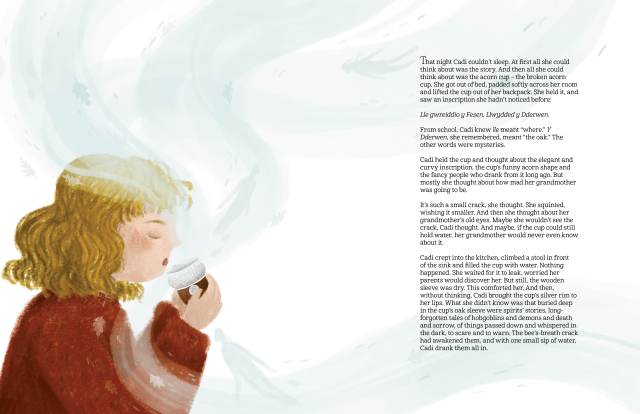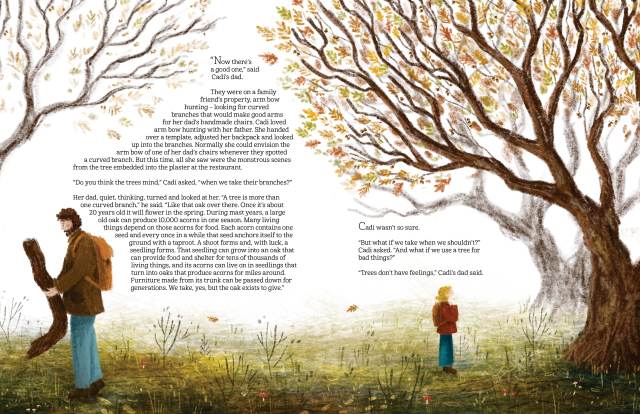
I experienced several surprising coincidences and discoveries while working on “Cadi & the Cursed Oak.” In the beginning, all I had was a short passage about the Nannau oak while working on “Honest Labour.” To turn the tale into a children’s book, I wanted the story of the oak to be so much more than what happened on that fateful day in 1402, when Hywel Sele and Owain Glyndŵr went hunting, which is the tale that has long made the Nannau oak famous.

The longbows carried by Owain and Hywel on their hunt brought to mind an entirely different hunt – an Instagram post by Welsh stick chairmaker Chris Williams in which he was arm bow hunting with his daughter, Alice.
Couldn’t my main character, I thought, be a Welsh stick chairmaker’s daughter? Hence, Cadi.
I spent hours considering Welsh names. At the time, Cadi ranked No. 90 on a “popular names in Wales,” list. It’s one of the Welsh diminutives of Catrin (then ranked No. 82). Owain Glyndŵr had a daughter named Catrin, Catrin of Ferain (c. 1540-1591), a noblewoman known as “the mother of Wales.”
How do you connect a present-day character to a tree that no longer exists and an event that took place more than 600 years ago?
That’s one of the beauties of wood, and a good editor.
I discovered there were actual objects claimed to have been made from the Nannau oak, that still exist today, including some acorn-shaped cups (how fitting!). The acorn cup became the tie between past and present, and the reason for which the story of the Nannau oak was passed down to Cadi.
After reading my first draft it was Christopher Schwarz who told me that he expected a scene in which Cadi drank from the acorn cup. After seeing pictures of it, he asked, “How could anyone not?”
I researched the cup some more. According to Remy Dean, it had been said “that those who drank from the cups were plagued by ghostly apparitions and suffered nightmares for several nights afterward.”
Without giving too much away (the book is, after all, only 48 pages), Cadi, finds the cup, accidentally cracks it, drinks from the cup and hides it by stuffing it into her backpack.
There are two silver discs attached to the wooden sleeve of the cup. In my research, I discovered that there are inscriptions on each disc. One is an engraving of an oak tree with the words Ceubren yr Ellyll, and 1813. The other? A coat of arms and ASGRE LÂN DIOGEL EI PHERCHEN: a good conscience is the best shield.
How apt.
Sometimes, when I’m in the thick of a project, I lose sight of the obvious. Months had gone by when I realized I had forgotten that the four acorn cups also have four inscriptions or toasts. (You can learn more about them here.) By this point, “Cadi & the Cursed Oak” had become longer and a bit more complex; the Nannau oak was also representative of stories that are passed down through generations.
Cadi’s grandmother pulled out a small pile of acorns from her coat pocket.
“These acorns may be from the same tree. Or different trees. They might be related to the blasted oak, holding its stories within. But each acorn has a different story, depending on where it grew on the tree, what it witnessed, where it fell – what it will be. All you can do is gather and listen. All of it, the bad, the good, the mundane, the thrilling, it’s all part of the acorn’s truth. And with time, the stories can change. In fact, they almost always do.”
Now Cadi was mad. She didn’t understand why things had to be so complicated. She didn’t understand why some stories could be so scary. Or sad. She didn’t understand why she had to be the one to find the cup and she didn’t understand why the cup had to crack – she didn’t want it to crack, she didn’t mean for it to crack. And she didn’t understand why the spirits’ stories were haunting her so.
“The worst thing you can do,” her grandmother said, interrupting Cadi’s angry thoughts, “is hide a story that needs to be told.”
They walked back to the car park, mostly in silence. As Cadi climbed into the car, her grandmother turned to her.
“Sometimes,” her grandmother said, “I hear the cries, too.”
Suddenly, Cadi realized what she had to do.

I fully expected the second inscription on the acorn cup to be something about a toast for a birthday celebration (which was the reason the acorn cups were made). Imagine my delight when I discovered the transcription:
Lle gwreiddio y Fesen, Llwydded y Dderwen: the oak tree may succeed where the acorn takes root.
It fit the story, particularly the already-written end, so beautifully.
Near the end of the production of “Cadi & the Cursed Oak,” we hired Dr Iwan Wyn Rees, lecturer and director of the Cardiff Centre for Welsh American Studies, to edit and correct the transcriptions, and create a simple pronunciation guide for the 20+ Welsh words and phrases we have scattered throughout the text. He was so incredibly thorough and patient and wonderful to work with. Also, as if it were meant to be, he said he remembers his Nain (grandmother) telling him that her own Nain was head housekeeper at none other than — the Nannau estate.
“Cadi & the Cursed Oak” is at the printer and will be available for $19 hopefully sometime in March.
— Kara Gebhart Uhl